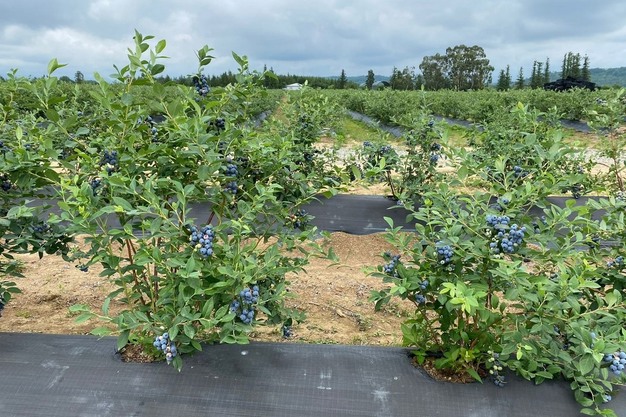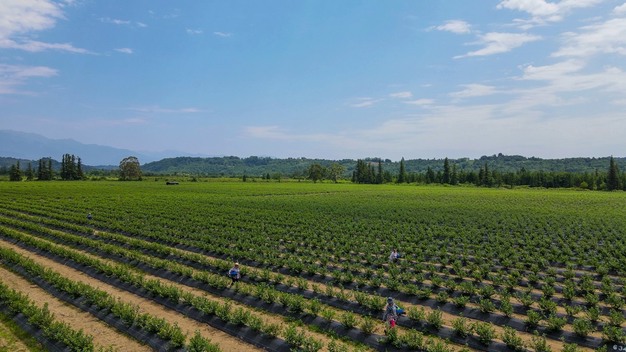The Georgian blueberry industry is thriving after its commercial start in 2011. Since then, production has increased significantly, says Shota Tsukoshvili, CEO of the Georgia Blueberry Growers Association: "The first commercial blueberry orchards were established in the country in 2011, as part of a pilot project in three regions. After years of research, trials, and evaluation of the varieties best suited to Georgia's climate, commercial production began expanding, especially after 2015. Since then, blueberry cultivation in Georgia has experienced rapid growth, surpassing 3000 hectares. The favorable harvest window, subsidies from government and support from donor organizations have made blueberries strategic crop in Georgia's agricultural sector."

According to Tsukoshvili, the yearly increase of the production of blueberry is due to the maturing acreage, and this growth is expected to continue in the coming years. "Blueberry farming in Georgia has seen remarkable growth in both hectarage and production over the past few years, positioning the country as an emerging player in the global blueberry market. As of 2024, 70% of total cultivated area is in its second or third growing year, meaning that the majority of commercial blueberry orchards haven't reached maturity yet. In around three years, Georgia's blueberry production will reach full capacity, rising to more than 25,000 tons."
Here's a breakdown of Georgia's blueberry exports in recent years:
• 2020: 665 tons
• 2021: 933 tons
• 2022: 1,392 tons
• 2023: 3,462 tons
• 2024: 4,980 tons
The growth can be attributed to investments and increasing knowledge of blueberry cultivation, Tsukoshvili explains: "This rapid growth is due in part to substantial investments in modern agricultural techniques, improvements in knowledge and favorable investment opportunities. Growing conditions in regions such as Samegrelo, Imereti, Guria and Adjara enable Georgian growers to produce blueberries from May to July in covered tunnels and open-field. In 2025, Georgia is set to export an impressive 7,000 tons of blueberries, marking a significant leap in production capacity. Looking even further ahead, the Georgia Blueberry Growers Association predicts that production will reach 20,000 tons by 2028. A major milestone that will solidify Georgia's role as a significant exporter of high-quality blueberries."

Tsukoshvili emphasizes the need for the industry to be less dependent on the Russian market for the blueberry exports. "Historically, the major market for Georgia's blueberry industry was Russia, with a 90% market share. Inefficient post-harvest practices, insufficient knowledge in agriculture and absence of food safety certificates have contributed to the export to Russia. The core purpose of Georgia's Blueberry Growers Association is to diminish the dependency on the Russian market and diversify exports. In 2023 and 2024, GBGA has managed to enter the EU market and grow the export volumes significantly. Currently, the share of Russian export is at a minimum among the GBGA members."
The next step is the cultivation of known varieties, Tsukoshvili states: "Recent investments by large blueberry growers and traders in Georgia have focused on innovative farming techniques to extend the production season and improve yields. One of the key areas of investment has been in the use of tunnel and pot production systems. Additionally, there has been a surge in the planting of Sekoya varieties. International companies that hold the license have begun partnering with Georgian growers, bringing both expertise and investments into the country. This collaboration signals a significant shift, as it means Georgian-grown Sekoya blueberries will soon be available on the global market, further enhancing Georgia's position as a competitive exporter of premium blueberries."

These strategic investments are helping Georgian producers not only meet increasing global demand, but also differentiate their products with higher quality and longer availability on the market, Tsukoshvili says. "The Georgian government and various donor organizations such USAID offer substantial subsidy grants to support agribusinesses. These grants are available for key areas such as planting, irrigation systems, and the establishment of cold storage facilities. Additionally, there is financial support for Georgian businesses to participate in international trade shows, helping them access global markets and expand their reach."
The Georgian Blueberry Growers Association is dedicated to continuously enhancing fruit quality by bringing in international expertise, Tsukoshvili explains: "We collaborate closely with agronomists and post-harvest consultants from Portugal, Italy, and Chile. Each year, more growers recognize the potential of the European market and are pursuing key food safety certifications such as GlobalGAP, GRASP and such. However, to take full advantage of these opportunities, we need to increase awareness of Georgian blueberries in the European market. It's crucial to communicate to European consumers and retailers that fresh blueberries from Georgia are available starting in mid-May, well before the harvest season begins in Northern Europe."
"Blueberry prices are fluctuating on a global market, with changes in climate conditions affecting the framework of supply and demand. The EU market is characterized with stable prices founded on market conditions during Georgia's harvest season. The overlapping of seasons with large blueberry producing countries such as Spain, Morocco, Serbia can have a negative impact on the average sales price of Geogia's blueberries," Tsukoshvili concludes.
For more information:
Shota Tsukoshvili
Georgia Blueberry Growers Association
Mobile +995 595 186350
Email: [email protected]
www.gbga.ge










